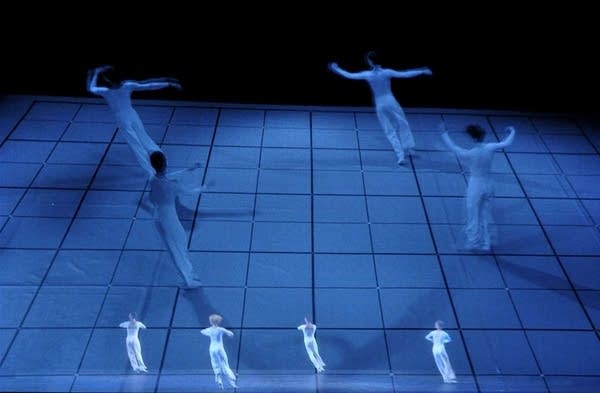Controversial dance returns 30 years after first run
Go Deeper.
Create an account or log in to save stories.
Like this?
Thanks for liking this story! We have added it to a list of your favorite stories.

In 1979 a dance performance at the Northrop Auditorium on the U of M campus in Minneapolis outraged the audience. Some people booed and walked out.
The object of the derision was a piece simply called "Dance" by choreographer Lucinda Childs with music composed and performed by Philip Glass. Now 32 years later Childs and Glass have returned to revive the piece at the Walker Art Center this weekend.
"Dance" is a three way collaboration. There's movement by Lucinda Childs, music by Philip Glass, and a film by visual artist Sol Lewitt.
The music is classic Glass: energetic with rapidly repeated motifs.
Turn Up Your Support
MPR News helps you turn down the noise and build shared understanding. Turn up your support for this public resource and keep trusted journalism accessible to all.
The film which shows dancers performing the piece plays on the back of the stage. Meanwhile live dancers perform the exact same moves on the stage itself. It's a mesmerizing effect, but in 1979 audiences reacted angrily, questioning if it was even dance. Childs and Glass remember the catcalls, and Glass says even worse.
"We actually had people throwing things at us," he said. He remembers seeing a dancer with egg smeared on his leg.

"We were simply doing what we did. We weren't trying to make people angry," he said. "What was surprising about it was how much in advance of the norms of dance and music that we had gone to. I personally didn't know we had done that."
"Philip and I never actually discussed it," said Childs. "You just sort of move on, and rise above it. It seems to me that someone who was there to throw eggs had purchased the eggs in advance," she smiles.
"Of course, you don't come to the ballet with eggs in your pocket," laughed Glass.
Bard College commissioned the revival of "Dance." Lucinda Childs built a new dance company for the show, but they are using the original Sol Lewitt film shot 32 years ago.
"The existing 35 mm black and white film of Sol Lewitt is very fragile, and there's a limit to how many prints you can make off the existing negative," Childs says. "So I was very pleased to have the opportunity to transfer the film work to a digital format, and also thanks to Philip we completely redid the soundtrack on the film."
There are other changes. In 1979 Glass played the music live, so he says he never really got to see the show.
"We actually had people throwing things at us."
"With the revival I can do that. I am in the audience for the first time. I love it actually!" he said. "I'm kind of astonished that the then young people that we were had the stamina and the vision could do something that still looks so solid. I'm impressed by those two people, whoever they were," he laughs.
Lucinda Childs says the live dancers follow the exact same choreography as their predecessors thirty years ago in the film. Yet modern techniques mean they look different somehow, which she loves.
Glass says audiences are different too.
"I don't think it would be possible to have the kind of anger and dismay and sometomes rage that there was provoked at that time," he said.
He believes the world has moved on and the dance world is much closer now to where they were then.
"You would have to be really uneffected by the work of the last thirty or forty years to be so innocent as to throw an egg. Or so clever, whatever you would want to say," he laughed again.
Philip Glass will be in the audience tonight at the Walker Art Center to see "Dance." After the show he'll join Lucinda Childs at a post-performance public reception. Next year they will collaborate again on the revival of another Glass work, "Einstein of the Beach."



